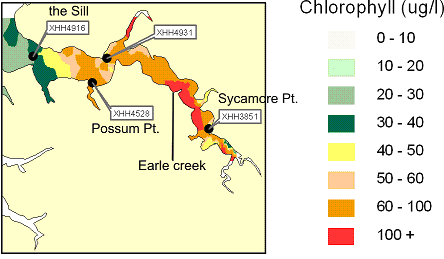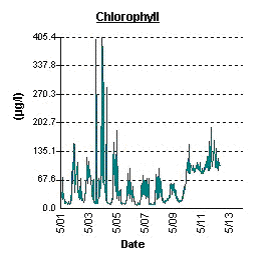|
||
|
The potentially
ichthyotoxic (i.e., fish killing) dinoflagellate,
Karlodinium veneficum,
has been blooming in the Corsica River. Samples collected by Maryland
Department of Natural Resources (MD DNR) water quality mapping team on May 5th
contained Karlodinium cells/ml in excess of 10,000 cells per ml
threshold at three sites (XHH3851= 14,859 cells/ml; XHH4931= 6,096 cells/ml;
XHH4528=26,924 cells/ml; XHH4916=24,765 cells/ml) (Figure 1). In addition,
Prorocentrum minimum
was also blooming at station XHH4916 (59,817 cell/ml). Both
species can cause the water to turn a deep reddish-brown color sometimes
referred to as Mahogany Tide (Figure 2). Total chlorophyll concentrations
exceeded 300-400 µg/l in some areas using in vivo fluorescence.
Figure1: Algae abundance (chl a) in the Corsica River on May 5, 2009.
Figure2- Reddish- Brown water in Earl Creek, a tributary to the Corsica. Photo taken by Jim Malaro, President of the Corsica River Conservancy. While Karlodinium has been associated with fish kills in Chesapeake Bay in the past, no evidence of fish kills were present during this bloom. Laboratory results from Dr. Allen Place at the Center of Marine Biotechnology in Baltimore, MD, revealed the water samples collect on May 5 contained karlotoxins, a toxin produced by Karlodinium and shown to have fish killing ability. While concentrations were not at a level to kill fish directly, two sites (XHH4916 and XHH4528) exceeded levels which are documented to produce gill damage in fish. Water quality data collected by MD DNR’s continuous monitoring station at Sycamore Point shows increasing levels of chlorophyll (an indicator of the amount of algae active in the water) as well as increasing concentrations of the pigment phycoerythrin (and indicator of food availability for Karlodinium) (Figure 3). Follow-up data collected by MDNR real-time monitoring crew on May 12 revealed the bloom of harmful algae species was generally replaced by a spring diatom bloom (>300,000 cells/ml) at Sycamore Point whereas Karlodinium and P.min were down to 3,302 and 16,000 cells/ml respectively.
Figure 3 - Algae abundance (chl a) and phycoerythrin concentrations at Sycamore Point real-time monitoring site on the Corsica River, May 2009. In the past, the State has largely spread available resources to all areas where restoration is needed. This has generally stabilized water quality or produced small improvement in many areas, but has not reached the point where a specific water body has been declared restored. To address this, the Targeted Watersheds Program is designed to focus efforts in a detailed watershed. The Corsica River Watershed Project was the first pilot program designed to demonstrate that we can successfully restore a Maryland river that drains into the Chesapeake Bay. The end point is to attain the new State water quality standards and remove the Corsica River from the Impaired Waters List. |




